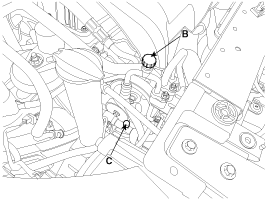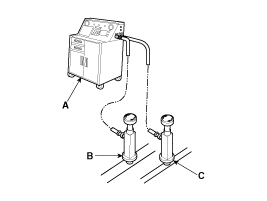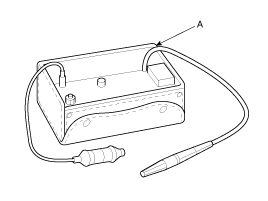 Kia Sedona: Repair procedures
Kia Sedona: Repair procedures
Third generation YP (2014-2025) / Kia Sedona YP Service Manual / Heating,Ventilation And Air Conditioning / Air conditioning System / Repair procedures
| Refrigerant Recovery |
Use only U.L.-listed service equipment that is certified to
meet the requirements of SAE J2210 when removing HFC-134a (R-134a) from
the air conditioning system.
|
If accidental system discharge occurs, ventilate work area before resuming to service.
Additional health and safety information may be obtained from the refrigerant and lubricant manufacturers.
| 1. |
Connect an R-134a refrigerant
Recovery/Recycling/Charging System (A) to the high-pressure
service port (B) as shown, following the equipment manufacturer''s
instructions.
|
| 2. |
Measure the amount of refrigerant oil removed from the A/C
system after the recovery process is completed. Be sure to install the
same amount of new refrigerant oil back into the A/C system before
charging. |
System Evacuation
Use only U.L.-listed service equipment that is certified to
meet the requirements of SAE J2210 when removing HFC-134a (R-134a) from
the air conditioning system.
|
If accidental system discharge occurs, ventilate work area before resuming to service.
Additional health and safety information may be obtained from the refrigerant and lubricant manufacturers.
| 1. |
When an A/C system has been opened to the atmosphere, such as
during installation or repair, it must be evacuated using a R-134a
refrigerant Recovery/Recycling/Charging system. (If the system has been
open for several days, the receiver/drier should be replaced, and the
system should be evacuated for several hours.) |
| 2. |
Connect a R-134a refrigerant Recovery/Recycling/Charging
system (A) to the high-pressure service port (B) and the low-pressure
service port (C) as shown, following the equipment manufacturer''s
instructions.
|
| 3. |
If the low-pressure does not reach more than 93.3 kPa (700
mmHg, 27.6 in.Hg) in 10 minutes, there is probably a leak in the system.
Partially charge the system, and check for leaks (see Refrigerant Leak
Test.) |
| 4. |
Remove the low pressure valve from the low-pressure service port. |
System Charging
Use only U.L.-listed service equipment that is certified to
meet the requirements of SAE J2210 when removing HFC-134a (R-134a) from
the air conditioning system.
|
If accidental system discharge occurs, ventilate the work area before resume of service.
Additional health and safety information may be obtained from the refrigerant and lubricant manufacturers.
| 1. |
Connect an R-134a refrigerant
Recovery/Recycling/Charging System (A) to the high-pressure
service port (B) as shown, following the equipment manufacturer''s
instructions.
|
| 2. |
Add the same amount of new refrigerant oil to the system that
was removed during recovery. Use only specified refrigerant oil. Charge
the system with [1100 ± 25g (38.8 ± 0.88oz.)] R-134a refrigerant. Do
not overcharge the system as it may damage the compressor. |
Refrigerant Leak Test
Always conduct a leak test with an electronic leak detector
whenever leakage of refrigerant is suspected and when conducting service
operations that accompany disassembling, loosening or connecting of
fittings.
In order to use the leak detector properly, read the manual supplied by the manufacturer. |
If a gas leak is detected, proceed as follows:
| 1. |
Check the tightening torque of the connection fittings, and
if it is too loose, tighten to the proper torque. Using a leak detector
(A), check for gas leakage. |
| 2. |
If leakage continues even after the fitting has been
tightened, discharge the refrigerant from the system, disconnect the
fittings, and check their seating faces for damage. Replace at all times
even for a slight damage. |
| 3. |
Check the compressor oil and add oil if required. |
| 4. |
Charge the system and recheck for gas leaks. If no leaks are found, evacuate and charge the system again.
|
 Description and Operation
Description and Operation
Refrigeration Cycle
...
 Components and Components Location
Components and Components Location
Component Location Index
Engine Room
1. Ambient temperature Sensor2. Receiver-drier3. Condenser4. Compressor5. Discharge Hose6. Service Port (Low Pressure)7. Service Port (High Pressure)8. A/C P ...
Other Information:
Overdrive Clutch Control Solenoid Valve(OD/C_VFS) Schematic Diagrams
Circuit Diagram
...
Rear Door Latch Repair procedures
Replacement
[Front]
1.
Remove the rear door trim.
(Refer to Rear Door - "Rear Door Trim")
2.
Disconnect the rear door cable (A).
3.
Disconnect the rear door remote controller connector ...
Categories
- Home
- First Generation
- Second Generation
- Third generation
- Kia Sedona YP 2014-2025 Owners Manual
- Kia Sedona YP 2014-2025 Service Manual
Copyright © www.kisedona.com 2016-2025





